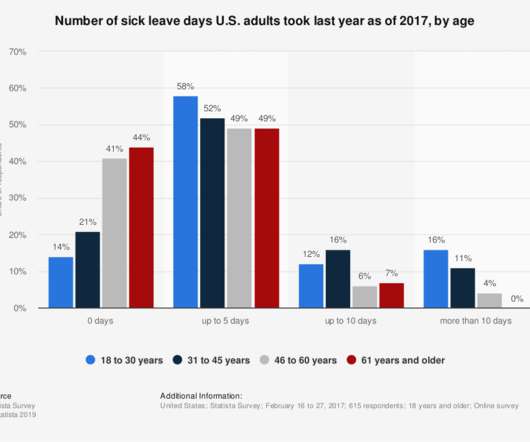Leadership Derailers: Fatigue as a Badge of Honor
Leadership Freak
JANUARY 24, 2020
Leadership is already challenging. Don’t make it harder than it needs to be. Ego confuses fatigue with importance. Leadership derailers: fatigue as a badge of honor.

Leadership Freak
JANUARY 24, 2020
Leadership is already challenging. Don’t make it harder than it needs to be. Ego confuses fatigue with importance. Leadership derailers: fatigue as a badge of honor.

AIHR
JANUARY 20, 2020
The absenteeism rate is a key measure of organizational health and well-being. Whether you measure it for the entire organization or an individual, knowing the exact absence rate will help shape interventions. In this article, we will explain the absence rate, how to calculate this rate according to ISO norms, and give some benchmarks on what a healthy and a high absenteeism rate looks like.
This site is protected by reCAPTCHA and the Google Privacy Policy and Terms of Service apply.

Kevin Eikenberry
JANUARY 20, 2020
As helpful as the maps app on your phone can be, have you ever been frustrated how the routes sometimes make no sense? Have you ever seen something from two different angles and seen something entirely different? Have you ever looked back a situation a day, or a week (or longer) later, and noticed something […]. The post The Power of Consciously Changing Your Perspective appeared first on Kevin Eikenberry on Leadership & Learning.

15Five
JANUARY 21, 2020
More and more company leaders, like CHROs and chief executives, are realizing that people managers are the key to success. This explains the massive adoption of technology tools in the last few years to enable manager-employee communication and performance tracking. We’ve known for years that software tools improve performance , and we’ve also known that manager training can significantly amplify those results.

Speaker: Chandra McCormack, CPA, MBA, NACD.DC
Technical degrees might open doors—but it’s the soft skills that keep them open. In the face of disruption, evolving workplace dynamics, and rising expectations of leadership, soft skills like communication, emotional intelligence, and presence have become core business essentials—not nice-to-haves. Inspired by stories from her father coupled with her own career journey, seasoned executive Chandra McCormack breaks down how to lead with impact, connect with purpose, and cultivate a workplace cult

Leadership Freak
JANUARY 22, 2020
Leaders are too concerned about doing everything right? Focus on showing up as your best self if you aspire to do things right. Justifications for worst-self leadership: #1. Burning hair.

Agile42
JANUARY 23, 2020
Nowadays, there are hardly any IT projects in which non-agile approaches are used. But what does agility mean for the rest of the organizations, is it a method or an attitude? I am very happy to be able to present this year at the Agile Beyond IT conference in Berlin , where they are creating a networking platform for mutual exchange of experience to promote agility in companies.
OrgDev Digest brings together the best content for management professionals from the widest variety of industry thought leaders.

High Scalability
JANUARY 24, 2020
Wake up! It's HighScalability time: Instead of turning every car into rolling sensor studded supercomputers, roads could be festooned with stationary edge command and control pods for offloading compute, sensing and managing traffic. Cars become mostly remote controlled pleasure palaces. Solves compute, latency, and interop. Do you like this sort of Stuff?

Leadership Freak
JANUARY 21, 2020
The path forward is uncertain and confusing: Multiple options present themselves. Future contingencies hide from sight. Decisions narrow or eliminate options. Conflicting advice calls from reliable sources. Results matter. You feel pulled between multiple options. One choice eliminates another. 4 decision-making principles: #1. Set a decision deadline.

Vantage Circle
JANUARY 24, 2020
Are you feeling stifled by the four corners of your office cubicle? Are you longing for the warm sunny ray that sips through your window during that board meeting? Well, guess what! It's normal for every human to long for nature's pleasantries since this is made possible through biophilia. Within the core of every human, there exists a connection to nature known as biophilia.

Kevin Eikenberry
JANUARY 21, 2020
There’s an old song that I like by The Everly Brothers, When Will I Be Loved? Or perhaps you’ve heard the Linda Ronstadt version? As a leader, this might be a question you’ve asked before – WHEN will I be loved? How do others feel about me as a leader? Am I making a difference? […]. The post When Will I Be Loved? appeared first on Kevin Eikenberry on Leadership & Learning.

Speaker: Jeremy York
Join us for a thought-provoking exploration of the rapidly evolving HR landscape as we examine how technological innovation, regulatory changes, talent strategies, and evolving diversity approaches are reshaping the profession. This webinar will provide HR professionals with practical insights on leveraging AI and emerging technologies while maintaining compliance in an increasingly complex regulatory environment.

Eric Jacobsen Blog
JANUARY 19, 2020
"The more specific you can be about your goal, the greater your level of success will be," explain authors Tom Pandola and James W. Bird , in their book, Light A Fire Under Your Business. "This is because once we have visualized something that doesn't yet exist, it causes our subconscious mind to make the decisions necessary to make that visualized goal a reality.

Leadership Freak
JANUARY 18, 2020
Dear Dan, I need help! I am the new manager to a team of experienced professionals. How do I earn their respect?

Vantage Circle
JANUARY 18, 2020
Are you part of the majority of the world's population who commute to work every day? According to the U.S Census Bureau, the average American worker spends 26.9 minutes commuting to work every day. And even as more and more employers around the world are adopting work-from-home policies and flexible schedules, commuting times don't show any signs of decreasing in duration.

Kevin Eikenberry
JANUARY 19, 2020
You’ve been in a leadership role for a while. You may even be leading other leaders. You have developed a routine and a rhythm as a manager. But your intuition and perhaps your results and feedback tell you that you have plateaued. One way or another, you know it is time to up your game […]. The post Next Level Leadership appeared first on Kevin Eikenberry on Leadership & Learning.

Speaker: Carolyn Clark and Miriam Connaughton
Forget predictions, let’s focus on priorities for the year and explore how to supercharge your employee experience. Join Miriam Connaughton and Carolyn Clark as they discuss key HR trends for 2025—and how to turn them into actionable strategies for your organization. In this dynamic webinar, our esteemed speakers will share expert insights and practical tips to help your employee experience adapt and thrive.

Eric Jacobsen Blog
JANUARY 24, 2020
"It takes more than encouraging words to get a team thinking beyond the ordinary," explains Jackie Barretta , author of the book, Primal Teams. She suggests you must help team members to redefine the purpose of their work with broader and more expansive thinking. Use certain pointed questions to guide a team toward a loftier view of their purpose. Specifically, Barretta recommends you as the leader ask the following purpose-broadening questions to encourage the team to think of providing value b

Leadership Freak
JANUARY 23, 2020
I don’t care for the idea of luck. I prefer Ralph Waldo Emerson’s approach, “Shallow men believe in luck. Strong men believe in cause and effect.

Vantage Circle
JANUARY 23, 2020
There is a 31% rise in productivity when your organization has happy employees. As an employer it is hard to oversee such an important statistic when productivity comes into play. Having happy employees in the organization is only possible when you create a happy workplace. A working environment where every employee looks forward to coming back to. Big names in the corporate world have learned that fostering a fun and learning environment has always led them to success.

Know Your Team
JANUARY 22, 2020
If you’re a new manager, here are the exact 1-on-1 meeting questions, agenda template, and approach you can take for your first 1:1 meeting with an employee. If there’s anything you should be supremely focused on as a new manager, it’s your first 1-on-1 meeting with an employee. That first encounter might seem like a formality to you. But in reality, it’s formative.

Speaker: Kaitlin Ruby Carroll
Retaining top talent in 2025 means rethinking benefits. In a competitive job market, fertility benefits are more than just offerings - they are a commitment to your team’s well-being. Gain critical insights into the latest fertility benefits strategies that can help position your organization as an industry leader. Our expert will explore the unique advantages and challenges of each model, share success stories from top organizations, and offer practical strategies to make benefits decisions tha

Eric Jacobsen Blog
JANUARY 23, 2020
The following great advice about how to apologize is from the book, The Courage Solution , by Mindy Mackenzie. She recommends you include these three elements when you apologize: Actually say "I'm sorry" out loud, while making eye contact, if possible. Acknowledging your error by adding the phrase "I was wrong.but more importantly, you were right." Asking humbly, "How can I fix this?

Accenture: OrgDev
JANUARY 22, 2020
Funnel vision is a common condition among sales organizations that focus on linear sales processes rather than a customer’s buying journey.

https://www.organizationaldevelopmentsolutions.com
JANUARY 21, 2020
More and more companies today have come to understand that employees are demanding that the company they work for fit their values and beliefs about how employees and coworkers should treat each other. They look at a company’s philosophy about customers and their beliefs about social causes. And most importantly, they look at organizational culture.

Vantage Circle
JANUARY 21, 2020
The success of any organization is determined by the quality of the relationship between an employer or management and employees. In order for these connections to be well-founded management must come up with genuine recognizing practices to keep the ball rolling. Unless this is done, turnover and worker discontent can be the result. It is important to realize the importance of employee recognition to avoid such expenses and loss of productivity.

Speaker: Jeremy York
2024 has tested every organization, and 2025 promises no less - the warning signs are everywhere. If you’re relying on superficial approaches to diversity, you might find yourself scrambling to catch up. Thought diversity - the fuel for new ideas, fresh perspectives, and disruptive innovation - is more than a buzzword. It's a survival strategy. And if you’re not building it into your workplace culture right now , you’re heading for trouble.

Eric Jacobsen Blog
JANUARY 22, 2020
Perhaps now more than ever it's time for the book by John Blakey called, The Trusted Executive: Nine Leadership Habits That Inspire Results, Relationships, and Reputation. The book is divided into three parts: Part One : Blakey explores how trust in executive leadership has been lost so that we can understand the scale and depth of the problem. Part Two : Here, Blakey shifts from exploring the theory of trustworthiness to studying its practice.

High Scalability
JANUARY 22, 2020
Follower clusters are a ScaleGrid feature that allows you to keep two independent database systems (of the same type) in sync. Unlike cloning or replication, this allows you to maintain an active, point-in-time copy of your production data. This extra cluster, known as a follower cluster, can be leveraged for multiple use cases, including for analyzing, optimizing and testing your application performance for MongoDB , MySQL and PostgreSQL.

Harvard Business Review
JANUARY 20, 2020
Begin with these five steps.

Leadership Freak
JANUARY 20, 2020
Poorly run teams are where talent goes to die. Talent thrives on effective teams. Talent dies where jerk-holes thrive. Where talent thrives: There’s more to success than meeting the numbers.

Speaker: Ann Meyers Piccirillo
From rapidly changing state-level labor laws and evolving workplace protections to new compliance expectations around pay equity and hybrid policies, HR teams are navigating a constant wave of regulatory updates. It’s not just about reacting anymore; it’s about anticipating risk, aligning stakeholders, and taking a smarter, proactive stance. In this session, we’ll cut through the noise and help you focus on what matters.

Eric Jacobsen Blog
JANUARY 21, 2020
If you lead a nonprofit organization, the one hour it will take you to read Peter F. Drucker's book called, The Five Most Important Questions You Will Ever Ask About Your Organization , will be well worth it. This book may fundamentally change the way you work and lead your organization. Perhaps one of most challenging questions Drucker asks the reader is: " Do we produce results that are sufficiently outstanding for us to justify putting our resources in this area ?

High Scalability
JANUARY 22, 2020
Who's Hiring? Sisu Data is looking for machine learning engineers who are eager to deliver their features end-to-end, from Jupyter notebook to production, and provide actionable insights to businesses based on their first-party, streaming, and structured relational data. Apply here. T riplebyte lets exceptional software engineers skip screening steps at hundreds of top tech companies like Apple, Dropbox, Mixpanel, and Instacart.

Harvard Business Review
JANUARY 24, 2020
A tribute from Christensen’s friend and colleague, Michael B. Horn.

Vantage Circle
JANUARY 21, 2020
British business magnate and author, Sir Richard Branson says: “Clients do not come first, employees come first. If you take care of your employees, they will take care of the clients.” In these few words, the founder of the Virgin group aptly sums up the importance of employees for any business. The adage also implies that businesses, regardless of their size, have to actively invest in employees.

Speaker: Radhika Samant and Todd Wuestenberg
Employee recognition has often been deemed a "feel-good" initiative, tied closely to rewards. While we understand its importance, we tend to associate recognition with intangible outcomes like engagement and sentiment, rather than direct impacts on retention and high performance. In today’s workplace, the true ROI of recognition lies in its ability to regenerate tangible, business-driven results.
Let's personalize your content